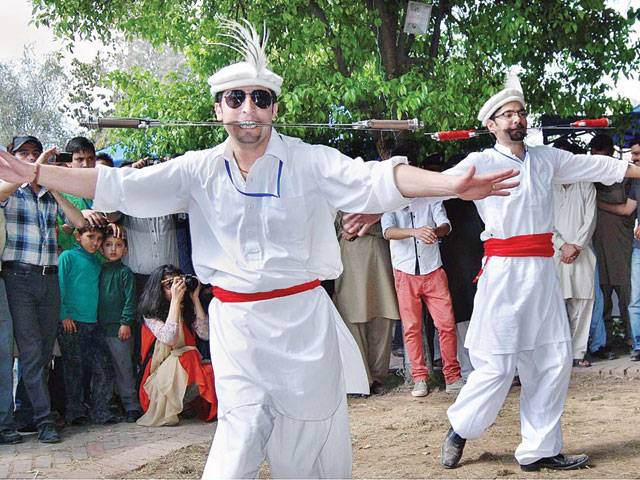ISLAMABAD - The 10-day Lok Mela (folk festival) is in full swing at Shakarparian with all its festivities attracting the residents of twin cities of Rawalpindi and Islamabad in large number.
The folk festival, organised by the National Institute of Folk and Traditional Heritage (Lok Virsa), started on April 11 (Friday). It is aimed at documenting and preserving traditional folk crafts and projecting craftspeople.
The glimpses of rural folk and traditional heritage of different provinces and regions, including far off areas, have coloured the grounds of Lok Virsa.
Besides many features for families and children, artisans-at-work are a major attraction for the visitors of Lok Mela. Over 500 craftspeople are seen actively demonstrating their works in artistically designed cultural pavilions, putting their creativity in arts, crafts and innovation. They are mesmerizing the visitors with their unique artisanship.
The crafts on display are embroidery (including Multani, Bahawalpuri, Hazara, Swat, Balochi and Sindhi), block printing, lacquer work, Khussa making, pottery, tie and dye, doll making, khaddar weaving, truck art, wood carving, wood work, papier mache, namda & gabba, metal work, Shawl weaving, zari work, motikari, traditional carpets, blue pottery, Ajrak, wax printing, stone work, wooden spoon making, pattu weaving and many others.
Being a prime institution dealing with Pakistani folk culture, Lok Virsa is cognizant of the need for gender equality which is seen in each event that it holds from time to time, because in this way both male and female practitioners afford equal opportunity of showcasing their talent and getting due recognition thereof.
In the present event too, a number of female artisans can be seen demonstrating their skills. The most prominent among them is Mst Malookan Bibi from Balochistan. She practices Balochi embroidery and has carried on this centuries old tradition from her mother and devoted 32 years of her life to this profession. She stands out not only for her excellence, but also for propagation of this art by imparting it to the future generations.
Another craftswoman Pari Bibi hailing from Badin, Sindh, weaves Farasi (traditional rug). She is a 70-year old artisan carrying the art of weaving since childhood.
Male artisans are also equally good in showing their art work. Shah Behram, a craftsman in Taghar (traditional woolen rug) from D.I. Khan, Khyber Pakhtunkhwa is showcasing excellent display. Ameer Bukhsh is an expert in natural dyes from Kahror Pucca, Punjab. The ancient art of wooden block making has its centres in the lower Indus Valley encompassing southern Punjab and all of Sindh. He has not only trained his family members, but also imparted training to many artisans.
in other crafts of textile.
Haji Habibur Rehman from Rawalpindi, Punjab, is the master artisan in truck art. This colourful, sometimes dazzling, art is not only done on the bodies of trucks, but also other vehicles and means of transportation like buses, tankers, mini-buses, rickshaws, tongas and even donkey carts moving on the road throughout the country.
Deedar Ali, an expert in patti weaving (woven strip made from sheep wool) from Gilgit Baltistan, is also seen actively demonstrating his workmanship.
Talking to this scribe, Lok Virsa’s Executive Director Mrs. Shahera Shahid said Pakistan with its rich and varied heritage had a craft tradition of more than 9,000 years dating back to the Mehergarh civilisation in Balochistan, which was evident from pottery production.
The Indus Valley civilization of Mohenjodaro in Sindh and Harappa civilization in Punjab (5,000 B.C.) indicated impressions of woven cloth production from cotton and wool. The dominant historical influence still to be seen in the form, design and colour of Pakistani handicrafts was essentially Islamic, a fusion of Turkish, Arab, Persian and the indigenous Mughal traditions, she added.
The crafts represent a valuable material heritage, which forms a tangible part of our historical and contemporary culture. Unlike the West, most traditional crafts in Pakistan are neither professions nor hobbies, but are an essential component of the diverse cultural patterns - a product of the ethnic and communal attitudes and practices. As such, crafts have meanings and definite social context in traditional society.
However, the onslaught of the industrial age is erasing this craft heritage, even in rural areas. But there is a recent trend towards the use of crafts as art objects in urban homes. Historic forms and designs are being revived both by the increasing number of trained craftsmen and by designers for the tourist and export trade.
The Lok Mela will continue till April 20 (Sunday) from 11 am to
10 pm.
Saturday, April 20, 2024
Folk festival in full swing

Caption: Folk festival in full swing
Pak economy improving, funds will be provided on request: IMF
9:57 PM | April 19, 2024
Minister advocates for IT growth with public-private collaboration
9:57 PM | April 19, 2024
Judges' letter: IHC seeks suggestions from all judges
9:55 PM | April 19, 2024
Formula 1 returns to China for Round 5
9:05 PM | April 19, 2024
Germany head coach Julian Nagelsmann extends contract till 2026 World Cup
9:00 PM | April 19, 2024
A Tense Neighbourhood
April 19, 2024
Dubai Underwater
April 19, 2024
X Debate Continues
April 19, 2024
Hepatitis Challenge
April 18, 2024
IMF Predictions
April 18, 2024
Kite tragedy
April 19, 2024
Discipline dilemma
April 19, 2024
Urgent plea
April 19, 2024
Justice denied
April 18, 2024
AI dilemmas unveiled
April 18, 2024
ePaper - Nawaiwaqt
Advertisement
Nawaiwaqt Group | Copyright © 2024





